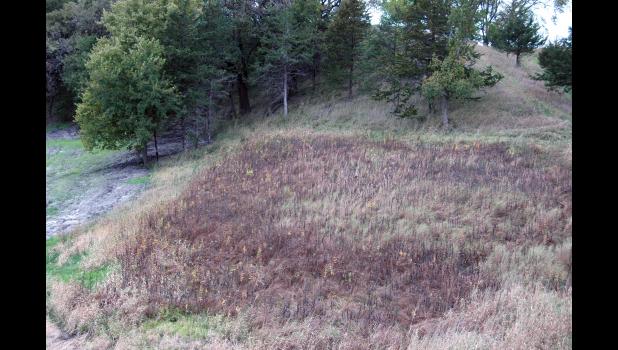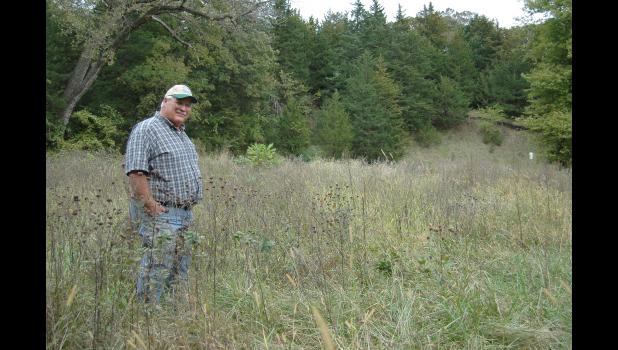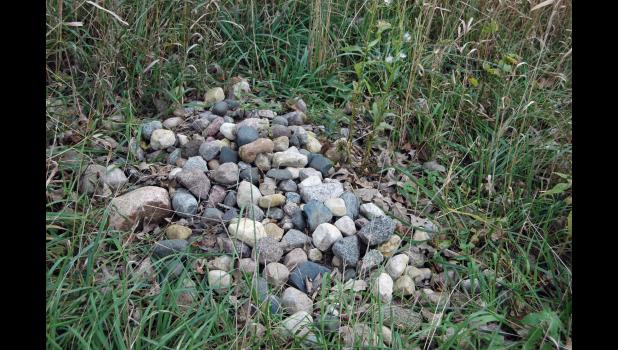THE UNLIKELY ENVIRONMENTALIST
By ANDREW MCGINN
Typically when construction equipment disturbs human remains, it’s in the guise of progress.
It’s probably not too often that a settler’s bones are accidentally unearthed in the course of putting nature back the way it was.
But that’s what happened several years ago northwest of Churdan as Jeff Pudenz worked to clear invasive trees from a newly documented fen on his 125-acre property.
A fen, which develops over thousands of years, is the rarest type of wetland in Iowa. Before he knew what he had, Pudenz casually referred to his as a bog, a patch of hillside that’s continually squishy thanks to the groundwater nourishing it.
The fen is now believed to be the southernmost in Iowa — a unique ecosystem that’s home to at least 47 different species of plants not found anywhere else nearby, by one botanist’s count.
Pudenz can’t do anything about the paved county road running alongside it, but the hillside again looks the way it might have when trappers up and down Cedar Creek, like the one whose nearby remains were reinterred under a pile of stones, each took their final breath in the brutal winter of 1856-57.
“I imagine he’d be glad it was preserved,” Pudenz, 63, surmised on a recent afternoon, sitting in the driver’s seat of the Ranger he uses to traverse his property, a conservancy in the making that has taken shape without fanfare.
“A lot of people think I’m crazy,” he added.
A lifelong farmer, Pudenz spends good money, and valuable time, restoring or protecting land that can’t and won’t be farmed.
“There’s a farmer mentality,” he explained. “If you can’t farm it, it’s worthless.”
The fen is a prime example. With enough plowing and underground tiling for drainage, someone else may be harvesting corn or soybeans on it right now.
Many fens in Iowa were destroyed, according to the Iowa Department of Natural Resources. There are only about 200 known ones in the state today.
Pudenz is thrilled.
“There aren’t many of these left,” he said, his eyes starting to twinkle. “And I own it.”
In January, Pudenz will be co-presenting a seminar, “Restoring and Enhancing Rare and Declining Habitats on Private Land,” at the Practical Farmers of Iowa annual conference in Ames.
His co-presenter, Darrick Weissenfluh, a fish and wildlife biologist with the U.S. Fish and Wildlife Service at the Union Slough National Wildlife Refuge north of Algona, considers Pudenz’s backyard near Churdan “an amazing property.”
“He’s got long-term vision, which is one of the tougher things for property owners,” Weissenfluh said of Pudenz. “He’s really unique. There’s literally nothing he won’t find a way to do to get a project done.”
In the seven years since moving in, Pudenz has planted 1,500 trees, built homes for wood ducks, nurtured tallgrass prairie and left dead trees for woodpeckers to enjoy. He keeps watch over an oak savanna, the likes of which were once sacrificed in the name of progress.
Of the tallgrass prairie that once covered 80 percent of Iowa, less than 0.1 percent remains.
“That’s bat habitat,” Pudenz said on this day, stopping his offroad vehicle on a network of trails next to a shagbark hickory tree.
Bats, which get up under the bark, are universally revered as beneficial.
Beavers, on the other hand? Not many landowners want those.
“Jeff actually does want beavers there,” Weissenfluh said.
Together in 2017, Pudenz and Weissenfluh constructed seven beaver dams behind his house on a small tributary of Cedar Creek.
No beavers have yet to move in, but the dams still help slow the stream’s flow, in turn catching sediment that might otherwise find its way into the Gulf of Mexico, where this past summer’s hypoxic zone caused by nutrient runoff far upriver — an area of low to no oxygen incapable of supporting marine life known as a “dead zone” — was the eighth-largest on record, at 6,952 square miles.
Just in May alone, heavy spring rains washed 156,000 metric tons of nitrate and 25,300 metric tons of phosphorus into streams that feed the Mississippi River watershed, according to the U.S. Geological Survey.
The excess nutrients come primarily from chemical fertilizers and manure intended for farm crops, golf courses and lawns.
Once they reach the Gulf, they promote a massive growth of algae, which then die and decompose, robbing the water of oxygen.
It’s an annual phenomenon that could worsen if the National Climate Assessment holds true. The government predicts that, as the climate changes, heavy rain events will become the norm in the Midwest.
The restoration last month by Pudenz and the U.S. Fish and Wildlife Service of two oxbows on his property will serve to further reduce the amount of nutrient-rich dirt flowing downstream.
Oxbows are remnant meanders of rivers and creeks cut off by erosion or human activity.
Cedar Creek has been altered through the years, including by the construction of D Avenue.
For years, as Pudenz explained, whenever Cedar Creek flooded, the waters would wash little silvery minnows known as Topeka shiners, an endangered species, out of the creek.
The restored oxbows will now hold floodwater, giving displaced Topeka shiners a place to live.
The diversity of habitat in such a relatively compact area is unique, Weissenfluh said.
“The proximity is special,” he said.
Pudenz knows so, too.
“I hope to turn it into a conservancy when I’m through with it,” Pudenz said.
Everything is contained within 125 acres.
By comparison, Whiterock Conservancy near Coon Rapids is spread out across 5,500 acres.
“There’s no reason we can’t have one up here,” he said.
Pudenz even built his house so that it could one day be turned into a learning center, complete with handicap-accessible restrooms. Sure enough, you can easily envision groups of schoolkids standing on his deck, keeping their eyes peeled for the bobcats Pudenz has seen.
Pudenz grew up three miles south of Lohrville, where he and his six brothers were river rats who tromped their way through this same area. In fact, when the realtor asked Pudenz if he wanted to take a stroll through the property before committing to buy it, he declined.
The realtor, he joked, probably thought that he had more cash than sense. It’s just that in his head, he knew every inch of it.
There is, however, a definite cost to the work Pudenz is doing — but how he makes his money is something of a revelation.
A 1974 graduate of Lohrville High School who’s been farming since he was 12, Pudenz readily admits he wasn’t born rich.
“Conservation farming,” he explained, “made me rich.”
Pudenz farms 720 acres in Sac County with his youngest brother. By being early adopters of conservation farming practices such as no-till, field buffers, cover crops and manure management, Pudenz said he’s managed to dramatically lower the cost of farming per acre.
“The people who hate me,” he said, “are the fertilizer companies and the machinery businesses.”
His type of farming requires next to nothing. And, in return, you can overturn any rock in his field, he said, and find at least two worms underneath.
“I’m not filling the Mississippi River with dirt,” Pudenz said.
But if you’re starting to think that Pudenz might be some liberal tree hugger, you’ve got it all wrong.
“I’m in conservation because conservation makes money,” he said. “Physical money.”
The guy who plants cover crops on his field and restores fens and oxbows at home is, in all actuality, a Trump-loving conservative who owns an M-16 with an attached grenade launcher.
He’s quick to pull out a novelty dollar bill with the Donald’s visage on it, and has a shirt hanging in his gun room with the word Liberals in a crossed-out circle, a la the “Ghostbusters” logo.
“What is a conservative?” he asked. “The more you conserve, the more you have for the future.”
“As a conservative,” he added with an edge, “you don’t let your resources go down the river.”
And, yet, down the river they go.
According to the Iowa Nutrient Reduction Strategy — which hopes to decrease loads of nutrients to the Gulf of Mexico through voluntary measures by 45 percent — cover crops are on the increase in Iowa.
Back in 2011, cover crops were planted on just 15,000 acres in Iowa. As of 2017, that number had increased to 760,000 acres — 330,000 of which were planted with the help of government cost-share programs.
Success! Right?
Well, the Iowa Nutrient Reduction Strategy estimates that at least 10 million acres of cover crops will be needed to meet goal.
The state also needs more nitrogen-reducing wetlands, according to the Iowa Nutrient Reduction Strategy’s most recent annual report, released in March.
Lots more — from 104,000 acres currently to between five and 10 million acres of wetlands.
“You can never tell a farmer nothing,” Pudenz said.
That is, Pudenz added, until his neighbor starts making money.
“Nothin’ talks to farmers like money,” he said.
Pudenz now has so few expenses, he explained, he doesn’t have to farm fencerow to fencerow.
“You farm the best and give the government the rest,” he said.
There’s good, old-fashioned money to be made through conservation.
“You don’t plant a tree because you love trees,” he said. “It shades you. It protects you from the wind. It has a dollar value to it.”
The black dirt that so easily washes downstream took centuries to make, Pudenz said, and will never return in this lifetime.
“The secret,” he said, “is to leave it like God made it, or put it back the way God made it.”
This, we can all agree, is what you call making America great again — one restored oxbow and a few happy Topeka shiners at a time.
- Log in to post comments





